Blyth St Mary and St MartinFeatures and Fittings
Wall painting
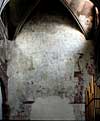 Wall painting Wall painting |
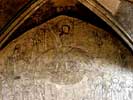 Christ Christ |
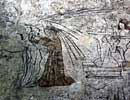 Angel Angel |
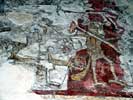 Demon Demon |
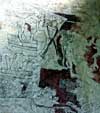 Hell Hell |
The wall painting is in two zones with the Last Judgement, or Doom, occupying
the larger part of the wall. It consists of the figure of Christ, one hand
raised in blessing, seated on a rainbow at the top of the painting surrounded
by angels holding symbols of the Passion with ten of the Apostles ranged below
and shown standing rather than seated. A female figure to Christ’s right
may be the Virgin, with St John the Baptist on his left. Figures are shown
rising from their tombs, which are depicted like stone sarcophagi with one
more elaborate one for a crowned figure. One larger-scale angel assists the
saved, on the north side, and another, with a raised sword pushes the damned
towards Hell. The red ground to the region of Hell is still vibrant, with the
outlines of fierce demons to be seen although the figures have not survived.
Most of the paint surfaces and hence the details have been lost, but there
are areas where the loss has not been so great, such as in the lower corner
where a wheelbarrow in which lost souls are transported to Hell survives. A
clearer example can be seen in the west window of Fairford church in Gloucestershire
from around 1500.
The Doom painting ends with a red border and the area beneath is divided
into a series of panels in two registers to form a painted retable to an altar
in front of the wall. Although badly damaged the paintings have been identified
as parts of a Passion cycle. The scenes are, the Entry into Jerusalem, the
Arrest and Betrayal, Christ among the tormentors, Judgement of Pilate, Christ
carrying the cross, and the Pieta. The centre of the painting has been lost,
doubtless due to the siting of Edward Mellish's tomb here between c1703
and 1885.
Font
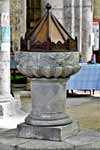 Font and font cover Font and font cover |
Font bowl circular with winged cherubs’ heads and lower edge with
gadroons on a plain circular shaft with simple moulded base, 17th or early
18th century.
Cover modest octagonal with finial and projecting ribs. Designed by Charles Hodgson Fowler, carved by Mr Bowman of Stamford, and dedicated by the vicar on 19 May 1907.
Lectern
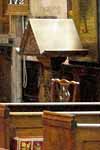 Lectern in the Lectern in the
south aisle |
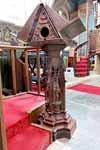 Lectern at All Saints' Lectern at All Saints'
Pavement, York |
The oak lectern now at the east end of the south aisle was dedicated by the vicar on 19 May 1907. A report on the ceremony and a description of the lectern is provided by The Retford & Worksop Herald and Gainsborough Leader:
'On Whit Sunday, at the eight o’clock celebration, the Vicar dedicated to the glory of God and in memory of Miss Crofts, of the Mantes, Blyth, a beautiful oak lectern, the gift of the Misses Pollitt, formerly residents of the parish. It is a copy of the lectern now in All Saints’ Pavement, York, dated A.D. 1420, which chained to it a copy of the works of Bishop Jewel, of Salisbury, dated A.D. 1566. The lectern is a double desk, with figures of the four Latin doctors under elaborately carved canopies adorning the stem, and is a very handsome addition to the ornaments of the church. It was carved by Mr. Milburn, of York.’
George Walker Milburn, woodcarver and sculptor, was commissioned in 1887 by architects Fisher & Hepper to add carved figures to the shaft of the 15th century lectern at All Saints' Pavement in York.
Information on the lectern and font cover was kindly supplied by Dr Tony Power.
 The
nave screen The
nave screen |
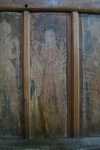 |
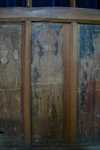 |
Detail of two of the figures |
Nave screen
The first bay to the west of the wall with the Doom painting is closed off
with a wooden screen of twelve panels arranged in four groups of three separated
by supermullions. The centre section is open and has a row of five traceried
heads, none of which is medieval. The whole has a battlemented cornice. It
was placed here in the later 19th century, and damage to the pier behind it
indicates that a screen with a loft was here previously, this was probably
the gallery built by Edward Mellish in the 17th century when the east bay of
the nave formed his family's private pew. The lower panels have figures of
saints, most of which are too worn to be deciphered, but figures of St Zita
and St Bridget of Sweden have been identified. Some of the male saints
wear plate armour and are likely to be warrior saints.
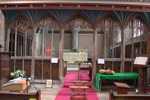 The
south aisle screen The
south aisle screen |
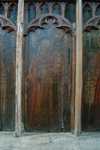 |
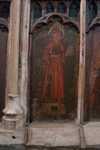 |
Detail of two of the figures |
South aisle screen
A wooden screen is sited at the end of the second bay from the east of
the south aisle to create a sanctuary area. The screen has a canopied loft,
vaulted on both sides with a fleuron frieze and cresting to the west
face but not the east. The screen is divided into four groups of three arched
heads separated by supermullions. A larger open arch forms the centre, but
was originally intended to be over a bay with lower panels. Six of the lower
panels have figures of saints surviving.
From the north, they are believed to be:
St Stephen, dressed as a deacon and tonsured, holding a book in his
right hand and a pile of stones in his left, with a further stone on the
wound on his head;
St Agatha, with her robe pulled open to expose her breast which is pierced
by a sword, her hands are clasped in prayer and her long blond hair extends
behind her;
St Edmund, with a crown and an ermine-trimmed robe holding four arrows
in his right hand and a sceptre in his left;
St Helena holding the Cross in her right hand and a staff in her left;
St Barbara holding a palm in her right hand and a large tower with a pennant
flying from its roof in her left;
St Ursula in a tightly belted gown covered by a cloak within which she
shelters two groups of naked small figures, and holds an arrow, or cross-bow
bolt in her left hand.
The female saint with the sword piercing her breast is identified in the
antiquarian literature as St Euphemia, but this is an unusual subject
for a medieval screen panel, and it is more likely that it is an image of
St Agatha who was martyred by having her breasts cut off. Two of the
figures are of a larger scale than the others, St Edmund and St Helena,
and may have been moved from another screen.
Parclose screen
There is a screen on the north side of the parish chancel which appears to
be wholly 19th century.
Woodwork of chancel stalls
The oak box pews that are visible in early photos of the church have been
dismantled and used to line the walls of the parish chancel on the south side,
together with a date panel with the inscription
The latter part of this could be read as ‘W.O. Church Warden’ or
it may be the initial of two wardens. One of the doors to the pews is also
included, and the decorative cresting has been placed at the top of the panelling.
The pulpit has the same design of panelling and decorative cresting and seems
also to have been made of the timber from the box pews.
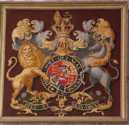 Royal
Arms Royal
Arms
On a square panel over the south door, with a burgundy background. Quarterly
of four, 1st and 4th, gules three lions passant guardant (England), 2nd, or
a lion rampant within a tressure fleury counter-fleury gules (Scotland), 3rd,
azure a harp or, stringed argent (Ireland), in pretence party per pale and
per chevron 1st, gules two lions passant guardant or (Brunswick), 2nd, or within
a semee of hearts gules, a lion rampant azure (Luneburg), 3rd, gules a horse
courant argent (Westphalia), at pretence, gules the crown of Charlemagne or
(Holy Roman Empire), arms of Hanover and having the Electoral Bonnet over.
Arms within the Garter motto, Honi Soit qui Mal y Pense. Crest, above
a Royal crown, a lion statant crowned or. Supporters, a lion or and a unicorn
argent, crined or, with coronet and chain affixed. Mantling, ermine and or.
Royal motto, Dieu et Mon Droit, in base with Tudor roses, a shamrock
and a thistle, for the United Kingdoms. Arms of 1801-1816, for George III (1760-1820).
Benefactors Boards
Under the tower, on the north wall. Two canvas panels from the 18th century
listing in gold lettering on a black background the charitable donations
of individuals towards the inhabitants of Blyth and the uses to which these
were to be put.
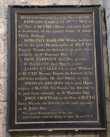 East
side East
side
BENEFACTIONS to the Poor of the Town of BLYTH
EDWARD FARFOOT left by Will to
the Poor of BLYTH a House and some Land
at Scaftworth, of the annual Value of about
Thirty Shillings.
DOROTHY BARLOW, Widow, his Sister,
left to the poor Housekeepers of BLYTH
Twenty Pounds; the Interest to be paid them
annually on St Thomas's Day.
EDW. FARFOOT died Dec. 19. 1728.
D. BARLOW died March 14. 1754.
JAMES RYALLS left to poor Widows
of BLYTH Twenty Pounds; the Interest to be
paid them annually. He died March 20. 1703.
THOMAS GREAVES left to poor House-
keepers of BLYTH Ten Pounds, the Interest to
be paid them annually on St. Thomas's Day.
JOHN CROFTS left to the Poor of BLYTH
Forty Pounds; the Interest to be paid annually
on St. John's Day
The sweet Remembrance of the just
Shall flourish, when he sleeps in dust. Ps. 112. 6. N. V. |
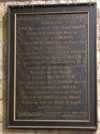 West
side West
side
BENEFACTION to the Poor of the Parish of BLYTH
WHEREAS
THE Reverend MR WILLIAM SMITH
Lecturer of Allhallows, Barking,
In the City of LONDON
And Son of RICHD SMITH of this place Gent
Did, by his Last WILL,
Leave the Sum of THIRTY FIVE POUNDS
to the POOR of the Parish of BLYTH;
The Vicar, Ch-Wardens, Overseers of the POOR
And the rest of the Inhabitants,
To perpetuate the Memory
Of so kind a BENEFACTOR,
Have agreed, that the INTEREST thereof
Shall be distributed, in BREAD,
By the Church-wardens, in the Church,
The first SUNDAY of every Month,
Beginning with the Month of August
Anno Dom. 1720.
Thine Alms are had in Remembrance in the Sight of God. |
 Drawings
of Drawings
of
masons’ marks |
Masons’ marks
The fabric of the nave has a number of masons’ marks to be seen on
its stone surfaces, although in common with most other buildings of the first
generation after the Conquest only a small proportion of the stone is marked.
The marks are consistent between the ground floor and the area above the
vault, which were the only areas available for inspection, and suggest that
construction work on the church progressed proceeded without a break of any
length.
|